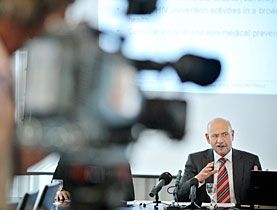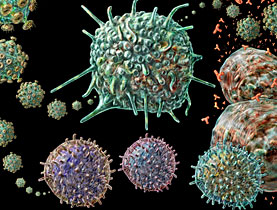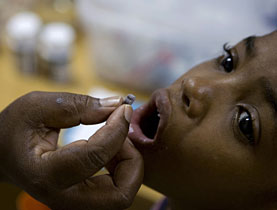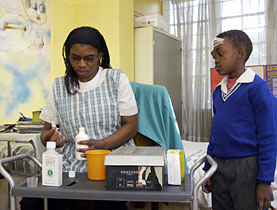Report criticises HIV/Aids red tape

An international panel assigned to evaluate Switzerland's HIV/Aids strategy says the country's coordination in fighting the pandemic could be "improved substantially".
Men who have sex with men and sub-Saharan Africans were two major areas of concern, Rolf Rosenbrock, the head of public health research at the Social Science Research Center Berlin told a media conference in Bern on Wednesday.
The panel, commissioned by the Federal Health Office, found that while Swiss authorities had instituted a “humane and effective” policy to combat the pandemic in the 1980s, grassroots activism and education gradually became overrun by bureaucracy as the disease evolved.
There is “no coherent strategy” to target gay men and men who have sex with men, and a lack of clarity on voluntary HIV testing, the panel said.
The study was commissioned as part of a broader review of the government’s HIV/Aids strategy. Said Rosenbrock of the current capacity to respond to HIV/Aids: “So far, we see good preconditions but not an optimal use of resources.”
Roger Staub, a senior official with the Federal Health Office, agreed that the system of funding non-governmental HIV/Aids organisations could be reconsidered.
“The system of funding by the federal government made NGOs more professional but more bureaucratic too. [It] is not keeping enough incentive for innovation,” he told swissinfo.ch
But Rainer Kamber, a journalist with the Swiss Aids Federation, an NGO, called the report a “very one-dimensional perspective”.
Kamber admits that prevention agencies “tend to rigidise their structures and have issues with innovation”, but the Aids Federation says it disappointed that it was not consulted on issues of men having sex with men.
“We’re the one organisation working in that field. We do not understand why that didn’t happen,” a spokesman said.
No death sentence
Once a death sentence, Aids has become a treatable and chronic disease in the developed world. Daniel Kübler, a Zurich University political scientist and member of the expert group, believes that the disease’s manageability has drawn the public’s attention away.
The panel has called for HIV prevention to be rooted into sexual health promotion programmes, especially those targeting high risk groups. Switzerland does not currently do this, it believes.
“If scare tactics or the fear of HIV was a motivating factor in the 80s or 90s, it is not necessarily as powerful now,” said Johnathan Elford, chair in evidence-based healthcare at City University London.
Rosenbrock says the Swiss Aids Federation, the country’s largest HIV/Aids organisation, must focus more on two separate high-risk groups: men who have sex with men and gay men.
“We think that is a very good idea and we should play a leading role in that,” the Aids Federation said. “It’s always a question about resources.”
Gay men are part of a self-identified social set, whereas men who have sex with men may be in heterosexual relationships, engaging in gay sex occasionally, such as when a female partner is menstruating.
“A phenomenon… not a group”
Calle Almedal, an expert who has worked as a senior advisor to the Joint United Nations Programme on HIV/Aids, has conducted research in bathhouses and other pick-up spots for casual sex since the 1980s.
“Some said they were gay, some said they were bisexual and some said that it didn’t matter,” said Almedal said. “It is a phenomenon. It is not a group.”
That makes it difficult to launch a targeted campaign. “How we do address men having sex with men in posters at the railway stations, targeting the general population, without leaving people with the impression that half of Switzerland’s male population is having sex with other men?” Almedal asked.
The panel has recommended a “much closer relationship between social prevention and medical prevention”. Almedal said the strategy for sub-Saharan immigrants must improve. “There is not such a bottom up approach there.”
He wants public health authorities to incorporate HIV/Aids into a broader public health strategy for that group of immigrants.
“Gay men and migrants are not being approached equally. Not strategically and not programmatically,” said Kamber of the Swiss Aids Federation.
“I believe that this panel has been assigned to answer quite specific questions about HIV and Aids. It has done that but obviously the whole area of HIV prevention in migrant groups has been highly understated.”
Justin Häne in Bern, swissinfo.ch
The Swiss government has identified three at-risk groups for HIV/Aids: gay men and men who have sex with men, people from countries with a high prevalence of HIV infection, especially in sub-Saharan Africa, and injection drug users.
Gay men and men who have sex with men have comprised 50% of new infections since 2002.
The Federal Health Office estimates that up to three in ten migrants from countries with a generalised HIV/Aids epidemic, mostly in sub-Saharan Africa, are HIV-positive.
The total population of this group is between 45,000 and 50,00.
The government’s HIV/Aids prevention strategy follows the “Three Ones” model outlined by the United Nations: to reduce the rate of new infections, provide counselling and therapy for affected individuals, and equal opportunities for affected individuals.
In the last two years, its prevention efforts will focus on: preventing the spread among the general population, stopping the further spread of HIV in at-risk groups, and preventing HIV transmission in couples where one person has HIV.
According to the Swiss Aids Federation, more than 30,000 positive HIV test results have been reported in Switzerland.
There are currently about 25,000 people living with HIV and Aids.
From the start of the epidemic to the end of December 2008, more than 8,800 cases of Aids have been reported.
5,782 people have died of the consequences of Aids.
In 2008, 778 new positive HIV test results were notified. Of these, 26 per cent were women.
Approximately 45% of all infections are due to heterosexual contacts.
Newly diagnosed infections in Switzerland in 2007 are classified into the following infection routes:
Heterosexual intercourse: 45%
Homosexual intercourse: 43%
Injecting drugs: 4%
Unclassified: 8%

In compliance with the JTI standards
More: SWI swissinfo.ch certified by the Journalism Trust Initiative



You can find an overview of ongoing debates with our journalists here. Please join us!
If you want to start a conversation about a topic raised in this article or want to report factual errors, email us at english@swissinfo.ch.